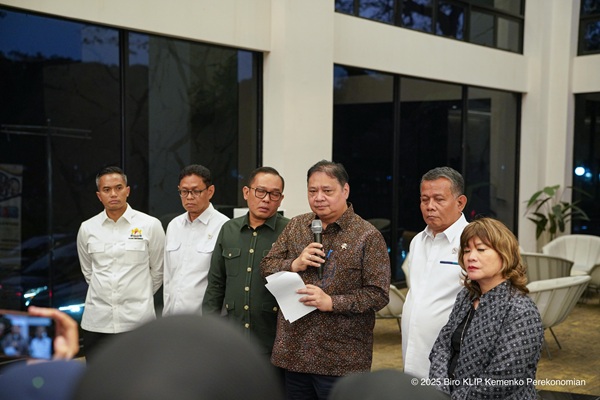
Jakarta - Following a series of intensive negotiations, the United States (U.S.) has agreed to significantly reduce import tariffs on products originating from Indonesia, lowering them from 32% to 19%.
This achievement stems from a high-level agreement between President Prabowo Subianto and President Donald Trump, making Indonesia the first country to reach a deal following the official U.S. statement issued in July.
As a follow-up to this tariff agreement, the Government has taken proactive steps to raise awareness among stakeholders. On Monday (July 21, 2025), a socialization event was held at the Coordinating Ministry for Economic Affairs, targeting business actors and industry associations. The session focused on the reciprocal U.S. tariff policy and its role in enhancing future investment and trade.
On this occasion, Coordinating Minister for Economic Affairs, Airlangga Hartarto, highlighted that the applied tariff rate for Indonesia is the lowest among ASEAN countries and several key competitors in export commodities.
“When we look at the figures, Indonesia’s tariff rate is the lowest compared to other ASEAN countries. Vietnam and the Philippines currently face tariffs of 20%, Malaysia and Brunei 25%, Cambodia 36%, Myanmar and Laos 40%, and Thailand 36%. In comparison with competitors in the textile sector, Bangladesh faces 35%, Sri Lanka 30%, Pakistan 29%, and India 27%,” said Minister Airlangga.
Minister Airlangga further explained that, in terms of Indonesia’s Most Favoured Nation (MFN) tariff structure, the MFN Import Duty structure as per the 2022 Indonesian Customs Tariff Book (BTKI) consists of 11,555 HS tariff lines. Of these, 1,347 tariff lines or 11.7% have 0% import duty, and 5,448 lines or 47.1% have a 5% import duty rate.
“With this new agreement, we aim to expand zero-percent tariffs with the U.S., as we have done with other Comprehensive Economic Partnership Agreements (CEPA) - including ASEAN-FTA, ASEAN-China FTA, IEU-CEPA, and agreements with Canada, Australia, New Zealand, and Japan – all of which have moved toward predominantly zero tariffs,” he added.
In addition to tariff reductions, both countries have successfully resolved various non-tariff barriers that have posed challenges to smooth bilateral trade. These developments will be further detailed in an official Joint Statement as a formal follow-up to the tariff agreement.
Furthermore, Minister Airlangga emphasized that the Government's planned purchases of certain U.S. products, as part of this new trade agreement, will not adversely affect Indonesia's trade balance. This is because the imported products – including agricultural commodities like wheat and soybeans, as well as energy products – are items that Indonesia already sources from other countries. The agreement will merely shift the source of imports rather than increase the total volume.
The agreed reciprocal tariff reduction provides strategic benefits for Indonesia, particularly in sustaining economic growth, ensuring food security, and stabilizing employment in labor-intensive industries. It is expected to help protect up to one million jobs. Moreover, the competitiveness of Indonesian products in the global market, such as palm oil, continues to rise due to growing demand in the U.S. and European markets.
“If this agreement had not been reached, we would risk losing competitiveness. One million people could have lost their jobs. The U.S. wants to be Indonesia’s partner – the third-largest democratic country and the largest economy in Southeast Asia,” Minister Airlangga asserted during the outreach session.
Finally, Minister Airlangga also explained that Indonesia is among the first group of countries to finalize an agreement with the U.S. As a result, the planned 1 August tariff adjustment will not apply to Indonesian products. The newly agreed 19% tariff rate will be officially announced in the forthcoming Joint Statement.
The event was also attended by the Deputy Chair of the National Economic Council (DEN), Deputy Minister of Cooperatives and SMEs, Deputy Minister of Finance, Deputy Minister of Industry, Deputy Minister of Energy and Mineral Resources, Deputy Minister of Investment and Downstream Industry/Deputy Head of the Investment Coordinating Board (BKPM), as well as representatives from other ministries and institutions, state-owned enterprises, and business associations.
National Economy
Regional Economy
National Economy
Regional Economy